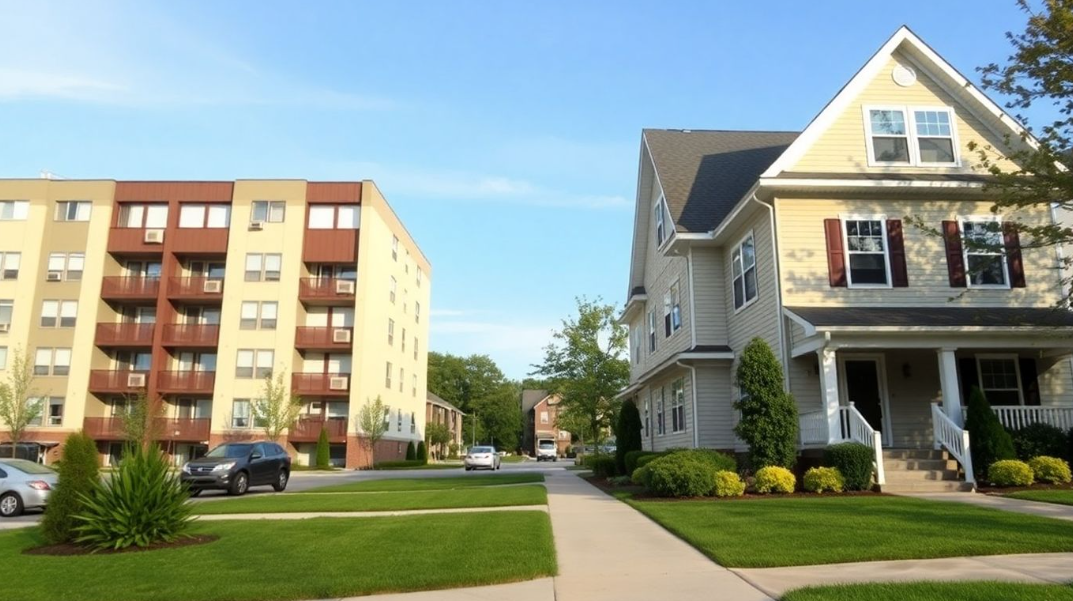Trying to figure out how much rent costs in the US these days isn’t easy. Prices keep changing, and it really depends on where you look and what kind of place you want. For 2025, the average rent in USA 2025 for an apartment is around $1,750 a month. But that’s just the big picture—some states and cities are way more expensive, and some are a lot cheaper. There are also big differences between tiny studios and larger homes. If you’re thinking about renting this year, here’s what you need to know about what’s going on with rent prices across the country.
Key Takeaways
- The national average rent in USA 2025 for apartments is about $1,750 per month, with big differences depending on state and city.
- Studio and one-bedroom apartments are seeing the fastest rent increases, while bigger homes are going up, but not as quickly.
- Montana and Idaho have the sharpest rent hikes in 2025, with some cities in those states seeing double-digit jumps.
- Places like Oklahoma, Arkansas, and North Dakota offer some of the lowest average rents in the country.
- Renters are still feeling squeezed, with vacancy rates staying low and more people competing for fewer available homes.
Overall Trends for Average Rent in USA 2025
The 2025 rental market trends USA are staying hot, just not as fiery as the last couple years. Renters across the country keep feeling the squeeze, and while price jumps aren’t as extreme as they were coming out of the pandemic, nowhere is rent really going down overall. Let’s break down what’s actually happening to the median apartment rent in America 2025 and house rental costs in the US 2025, and which forces are moving the needle.
National Median and Average Rent Costs
Rents are, honestly, still high pretty much everywhere. Here’s how the numbers are shaping up as of fall 2025:
| Rental Type | Median Rent 2025 | Annual % Change (2024-25) |
|---|---|---|
| All Apartments (average) | $1,750 | +4.8% |
| Studio | $1,384 | +5.9% |
| 1 Bedroom | $1,520 | +5.3% |
| 2 Bedroom | $1,830 | +4.8% |
| 3 Bedroom | $2,300 | +4.4% |
| 4 Bedroom | $2,681 | +4.1% |
- The average apartment is about 908 square feet, but that varies (studios and big houses are obviously way different sizes).
- 44.6 million households are renter-occupied, about a third of the country.
- Home renters are competing harder than ever—vacancy rates are at record lows.
Factors Impacting 2025 Rental Market
What’s pushing rents up? There’s no one reason, but a few things stand out:
- A long-term housing shortage—builders couldn’t keep up after the Great Recession, and it’s still a mess.
- High home prices and mortgage rates—buying is out of reach for many, so more folks are renting.
- Population growth in certain regions—some states and cities, especially in the Mountain West, are magnets for people, driving up demand fast.
- Inflation—while it’s lower than the last few years, everything still costs more, and that trickles down to rents.
- Low rental vacancy rates—there simply aren’t enough units available.
Comparison With Previous Years
Sure, rents aren’t skyrocketing like 2021–22, but the jump we’re seeing for forecasted rent prices US 2025 is still tough for many renters:
- From 2020 to 2024, average rents rose much faster, with some years hitting double-digit percentage jumps.
- Now, the expected rent increases USA 2025 are smoother, but five years of piling increases add up.
- Median rent is about 35% higher now than pre-pandemic.
- Some regions, like Montana and Idaho, are way above average—2025 growth there is more than four times the national rate.
If you’re trying to budget for a new lease, or just trying to keep up with rent hikes, these trends might make you feel you’re running hard just to stay in the same place. Still, knowing what’s happening and why can help you plan your next move (or at least brace yourself for the next rent notice).
Average Rent by Property Type in 2025
Rental prices for 2025 aren’t moving in the same direction for everyone—where you live and what kind of unit you’re renting makes a big difference. Let’s break it down by the main types of homes people are renting, from compact studios to family-sized houses. The story this year? Every type of rental is more expensive, but some more so than others.
Studio and One-Bedroom Unit Prices
The smallest units are seeing the sharpest jumps right now. Here’s how things are shaping up:
| Unit Type | Median Rent (2025) | % Change from 2024 |
|---|---|---|
| Studio | $1,384 | +5.9% |
| 1-Bedroom | $1,510 | +5.3% |
- Studios are now more in demand, maybe because renters are looking for anything they can afford. These tiny spaces jumped the most.
- One-bedroom units are following close behind. Single renters and couples often compete for these units, especially with homebuying out of reach for many.
- Even with higher prices, these units are sometimes the only realistic pick for people trying to save on rent.
Two-Bedroom and Larger Home Trends
The rent for bigger places—think two-bedrooms and up—is up as well, but not quite as much as smaller units:
| Unit Type | Median Rent (2025) | % Change from 2024 |
|---|---|---|
| 2-Bedroom | $1,725 | +4.8% |
| 3-Bedroom | $2,220 | +4.4% |
| 4-Bedroom | $2,681 | +4.1% |
- Families and roommates who need more space are having to pay more, but the increases aren’t quite as steep as for studios and one-bedrooms.
- Some folks are teaming up with roommates to afford larger places, since per-person costs drop (a little) when split.
- The pool of available larger homes is smaller, and a lot of those renters would’ve considered buying a house if mortgage rates weren’t so high.
Rental Growth by Apartment Size
There’s a clear pattern in 2025: the smaller the unit, the bigger the price jump. Why is that happening?
- Huge demand for affordable units: People getting priced out of buying or larger rental homes turn to studios and one-beds.
- Not enough supply: Construction hasn’t kept up with growth, especially at the lower end of the market.
- Higher moving costs: Some renters can’t afford to move up to bigger places, so competition stiffens for smaller units.
To summarize, 2025’s rental market is tough all around, but especially so for those seeking the smallest, cheapest options. Either way, be prepared—budgets are getting squeezed from every direction, no matter which property type you prefer.
State-Level Variations in Average Rent in USA 2025
Rent prices in the US can swing wildly from state to state, and this is especially noticeable in 2025. Rents aren’t just about local housing markets—they reflect everything from job growth and supply problems to population trends and wild surges in demand. Let’s look a little closer at which states are the most expensive, where rents are climbing fastest, and the places that are actually seeing rents dip.
Most Expensive and Affordable States
This year, states on the coasts and in certain urban centers continue to be the priciest for renters, while others stand out for being relatively affordable. Here’s a quick overview:
| State | Average Monthly Rent |
|---|---|
| California | $2,865 |
| Hawaii | $2,545 |
| New York | $2,428 |
| Montana | $1,940 |
| Alabama | $1,315 |
| Arkansas | $1,131 |
| South Dakota | $1,182 |
- California and Hawaii always seem to top these lists, and 2025 is no exception.
- Southern and Midwestern states (like Arkansas, South Dakota, and Alabama) continue to offer some of the lowest rents, even if they’ve seen small bumps this year.
States With Fastest Rent Increases
Some states are seeing rents spike much faster than the rest of the country. If you live in (or want to move to) the Mountain West, here’s what you should know:
| State | % Change in Rent (2024–2025) |
|---|---|
| Montana | +20.7% |
| Idaho | +20.3% |
| Virginia | +11.6% |
| Tennessee | +10.7% |
| Hawaii | +9.2% |
A few key things are pushing those numbers up:
- Population is growing quickly in Mountain West states like Montana and Idaho, putting more pressure on already scarce housing.
- Housing supply just hasn’t kept up, so even small increases in demand cause major rent bumps.
- Some states that have been historically more affordable are catching up fast, especially as remote work and lifestyle changes send new residents their way.
States With Declining Rental Prices
Not everywhere is feeling the pressure of big rent hikes. There are a few (rare) cases where rents actually fell in 2025:
| State | % Change in Rent (2024–2025) |
|---|---|
| Rhode Island | -4.8% |
| Wyoming | -4.1% |
| South Dakota | -4.0% |
What’s causing the drops?
- Some places went through a big surge during the pandemic and are now settling back down.
- Out-migration or a big release of new rental units can also ease prices.
- In certain states, specific cities or regions may be seeing job loss or lower overall demand, which puts a lid on rent growth.
To sum it up: In 2025, being a renter is a totally different experience depending on where you are. Costs are rocketing up in the Mountain West and still sky-high in the usual coastal hotspots, but a handful of states are even seeing minor relief. If you’re thinking about making a move this year, double-checking the local trends might save you a lot of money—or surprise you.
Major Metro Areas With Notable Rent Changes

The rental landscape across US metro areas in 2025 is all over the place. Some cities saw rents soar, while others caught a break with prices falling for the first time in years. Below, I break down which spots saw the biggest jumps, who’s enjoying lower rents, and where you can still find a reasonably priced place to live in a big city.
Cities Experiencing Sharp Increases
Rent is up across many metros, but a few stand out for especially steep hikes. Here are the large metros posting the most significant year-over-year rent increases:
| Metro Area | % Change (2024–2025) |
|---|---|
| Charlotte, NC-SC | +16.8% |
| Riverside, CA | +14.7% |
| Virginia Beach, VA-NC | +14.4% |
| Washington, DC-VA-MD-WV | +13.8% |
| Houston, TX | +13.3% |
| Nashville, TN | +12.5% |
| Richmond, VA | +12.5% |
Some midsize metros are outpacing even these large cities:
- Boise City, ID: +32.1%
- Knoxville, TN: +25.0%
- Pensacola, FL: +24.6%
Smaller places like Bozeman, MT saw eye-watering spikes around 37.4%—but if you want to stick to bigger cities, the changes above are what renters are up against.
Growth in these spots is being driven by population gains, ongoing housing shortages, and a steady flow of out-of-state newcomers looking for jobs or a different lifestyle. Renters are competing harder for fewer available units, sending prices sky high.
Metropolitan Areas With Falling Rents
Not all metros are riding the rent rollercoaster upward. A handful of bigger cities posted either modest bumps or even outright drops:
| Metro Area | % Change (2024–2025) |
|---|---|
| Indianapolis, IN | -4.0% |
| Providence, RI | -3.8% |
| Denver, CO | -3.2% |
| Hartford, CT | -1.1% |
| Boston, MA | -0.3% |
Midsize and small metros fared even better. Santa Maria-Santa Barbara, CA fell by a hefty 15.1%, after years of sky-high prices. Asheville, NC and Flint, MI also saw rents drop nearly 10% and 6%, respectively. These dips reflect a post-pandemic cooldown—people are less willing or able to pay the pandemic premium, and in some cases, more housing units have come online.
Affordable Large Cities to Rent
Believe it or not, there are still bargains if you know where to look. Here are some of the cheapest large cities for renters as of 2025:
| City | Population | Median Rent (1BR) | Median Rent (2BR) |
|---|---|---|---|
| Wichita, KS | 389,938 | $650 | $878 |
| Toledo, OH | 272,779 | $695 | $875 |
| Akron, OH | 197,597 | $775 | $895 |
| Baton Rouge, LA | 220,236 | $825 | $1,000 |
| Huntsville, AL | 200,574 | $839 | $1,025 |
Other affordable options:
- Cedar Rapids, IA
- Sioux Falls, SD
- Little Rock, AR
- Augusta, GA
These places tend to have more balanced markets, less population pressure, and sometimes even an oversupply of newer rental units. Affordable rents mean less stress on your wallet—though in exchange, you might sacrifice some amenities or weather perks that pricier cities offer.
In summary:
- Mountain West cities and some southern metros are on fire price-wise.
- High-cost coastal areas and a handful of Rust Belt metros are leveling off or dropping.
- There are still cheap options, usually in the Midwest and Southeast, for renters who put affordability first.
So if you’re thinking about moving or wondering why your rent shot up (or, lucky you, went down), where you live has never mattered more for your monthly budget.
Key Market Drivers for Rent Price Changes in 2025
Understanding why rent prices are moving in certain directions in 2025 comes down to a handful of ongoing pressures. Each has a pretty big impact, even if renters only notice one or two in daily life. Here’s a breakdown of what’s heating—and sometimes cooling—the market this year.
Impact of Housing Supply Shortages
Let’s start with the most obvious problem: there just aren’t enough places to rent. The inventory crunch isn’t anything new, but the effects are being felt even more now. Builders got burned during the financial crisis more than a decade ago, and new construction has lagged ever since. Fast forward to now, and the country is short millions of rental units—so rent prices keep climbing.
A few key ways low supply keeps rent high:
- More people are chasing the same apartments, bidding up rent.
- Fewer move-in specials or concessions from landlords.
- Little pressure for landlords to negotiate on price.
Here’s a quick look at vacancy rates:
| Year | National Rental Vacancy Rate |
|---|---|
| 2023 | 6.0% |
| 2024 | 5.2% |
| 2025 | 4.7% (projected) |
Lower vacancy means more competition and higher prices—plain and simple.
Population Shifts and Demand Patterns
People aren’t just staying put; they’re moving a lot, especially to states and cities with perceived opportunity or lower tax burdens. The Mountain West (think Idaho, Montana) is catching a lot of this movement, and rents in those places are skyrocketing. Younger renters, remote workers, and retirees are all part of these shifts.
Some factors driving these population moves:
- Affordability in one area runs out, so people look elsewhere.
- Flexible work means folks can leave expensive coastal cities.
- Local job booms (even in smaller metros) draw new arrivals.
States like Montana and Idaho are reporting rent jumps over 20% year-over-year, while others like Rhode Island are actually seeing decreases. Where people move, rents tend to react quickly.
Inflation and Economic Influences
After the wild inflation ride of 2021–2022, prices for just about everything went up—rents included. While inflation has cooled off some, most households are still catching up, and landlords are still feeling the pressure to cover rising costs. High interest rates have also kept many would-be buyers in the rental pool, competing for limited units.
Economic influences on rent right now include:
- Landlords passing on higher insurance and maintenance costs.
- More renters unable to afford down payments, staying put longer.
- Higher salaries in some areas make higher rents achievable for a segment of renters, raising the local bar.
And it’s not just numbers on a screen—the pinch is real. When basic goods and services cost more and income rises only a little (or not at all), rent hikes hit even harder.
In short, the story of 2025’s rents is about pressure from all angles: too few rentals, lots of moving, and lingering economic stress. Renters are feeling the squeeze, with very few easy fixes in sight.
Rent Affordability Challenges for Households

Cost Burden for Renters in 2025
It’s 2025, and rent prices are still squeezing a lot of American households. Even though rent hikes have slowed down a bit since their wild climb a couple years ago, those higher prices stuck around. A ton of people are spending over 30% of their monthly income on rent—some even more.
Here’s a quick table showing how many renters in different income brackets are considered “cost-burdened” (meaning they’re paying a big chunk of their paycheck toward rent):
| Household Income Level | % Paying 30%+ on Rent |
|---|---|
| Under $30,000 | 74% |
| $30,000 – $50,000 | 48% |
| $50,000 – $75,000 | 27% |
| Over $75,000 | 8% |
If you’re lower income, odds are you’re struggling more than ever to find a place you can actually afford. Several factors make this tougher, including limited new construction in many areas. As studies show, when new housing construction is restricted, everyone tends to pay more—especially those with tighter budgets.
Vacancy Rates and Tenant Competition
Vacancy rates stayed near historic lows this year. That means there just aren’t enough open apartments or houses for the number of people searching. Less turnover and limited supply make the competition for available rentals even more intense.
Here’s what’s going on:
- More renters are competing for fewer units.
- Properties in popular cities or near jobs fill up super fast.
- Landlords can raise rents or be more selective about tenants.
When you’re hunting for a place, it’s not unusual to show up at an open house and find a dozen other folks there, all hoping to get the same apartment. The stress is real, and some are forced to compromise on size or location—sometimes both.
Comparisons to Homeownership Costs
Owning a home might seem like a good alternative, but it’s not an option for everyone. Rising mortgage rates and higher down payments have kept a lot of renters from buying. So now you have a pile of people stuck renting, even if they’d rather own—driving up demand (and prices) for rentals.
A simple breakdown:
- Renters often spend a higher percentage of their income on housing compared to homeowners.
- Entry costs for buying a home (down payment, closing costs) are a huge barrier.
- With high interest rates, monthly mortgage payments are expensive, so the rent-versus-own debate isn’t clear cut in many places.
In short, whether it’s rent or a mortgage, the monthly bill for keeping a roof over your head is tough to handle for a growing slice of the population. Many folks are just crossing their fingers for a little relief next year.
Methodologies and Data Sources for Rental Estimates
Let’s talk about how these rental numbers for 2025 actually come together, because honestly, it can get pretty confusing if you’re not knee-deep in data all the time. Most people hear a number like, “The median rent is $1,550,” and just take it at face value. But there’s a whole process behind the scenes, with a few main players and a lot of spreadsheets.
Role of HUD and U.S. Census Bureau
When you see official stats, chances are they’re coming from one (or both) of these agencies:
- HUD’s 50th Percentile Rent Estimates: This is the go-to for most rent studies every year. HUD collects information about what new tenants are paying for all types of apartments and houses, then averages those rents out by location and unit size.
- American Community Survey (ACS): Run by the Census Bureau, ACS surveys millions of households each year, asking about everything from rent payments to household size. It’s pretty detailed and picks up trends that might not show up in smaller datasets.
- Rental Vacancy Rate Data: Also from Census, this tells us how many rentals are sitting empty at any given time—which matters, because high vacancy usually means less pressure on rents.
Private Data Analysts and Platforms
It’s not just government putting these numbers together. Some private companies collect listings and lease data straight from the market:
- Yardi Matrix: This firm tracks rents for large apartment buildings (usually 50 units or more), covering the lion’s share of metro populations. That means lots of real-time rental prices each month.
- ApartmentAdvisor and Similar Sites: These platforms scrape listings for active rentals, helping paint a picture of what’s actually available, not just what’s being paid by current tenants.
- Market-Specific Data: Different websites have different strengths—some are better for big cities, others for smaller towns.
Calculating Weighted Averages and Trends
Once all that raw info is gathered, researchers still have work to do. Here’s the usual approach:
- Weighting by Unit Size: Since there are more one-bedroom apartments than, say, four-bedroom rentals, each gets weighted by how common it is. That way, a spike in luxury home rents doesn’t skew the whole average.
- Adjusting for Population: Often, numbers for small, midsize, and large metros are separated to avoid weird comparisons. Researchers sometimes exclude places where data is spotty.
- Tracking Year-Over-Year Changes: The key metric is usually the percent change in median rent from last year to this year. A tie between cities? The location with the bigger dollar increase gets higher rank.
| Data Source | What It Provides | Useful For |
|---|---|---|
| HUD 50th Percentile Rents | Median rent estimates by unit size | National and metro trends |
| Census ACS | Survey-based rent/payment data | Demographic breakdowns |
| Yardi Matrix | Large-building asking rents | Real-time metro prices |
| Private Rental Platforms | Active rental listings/prices | Checking what’s on the market |
With all these streams of data and steps in the mixing process, it’s no wonder estimates can look a little different depending on who’s doing the counting. But the goal’s the same: nail down the number renters are likely to see in 2025, city to city, state to state, apartment to apartment.
Conclusion
So, that’s the big picture for rent prices in the U.S. in 2025. The average rent for an apartment sits at $1,750, but as we’ve seen, that number can swing a lot depending on where you live. Some states are way more affordable, while others are up there with the most expensive in the country. Rent has gone up in most places, though a few spots are actually seeing prices drop. It’s still tough out there for renters, especially with more people competing for fewer homes and apartments. If you’re looking for a new place, it helps to check out local trends and keep an eye on how things are changing in your area. No matter where you end up, knowing the numbers can make the whole process a little less stressful.
Frequently Asked Questions
What is the average rent for an apartment in the U.S. in 2025?
The average rent for an apartment in the U.S. in 2025 is about $1,750 per month. This number can change a lot depending on where you live, how big the place is, and what kind of building it is.
How big is the average apartment in the U.S.?
The average apartment in the U.S. is around 908 square feet. Studios are smaller and cheaper, while two- and three-bedroom places are bigger and cost more.
Which states have the highest and lowest average rents?
The most expensive states for renters are Massachusetts, California, and the District of Columbia. The cheapest states are Oklahoma, Arkansas, and North Dakota.
Are rents going up or down in 2025?
Rents are still going up in most places, but the increases are smaller than before. On average, rents are about 4.8% higher than last year, with some states seeing much bigger jumps and a few states seeing rents drop.
What makes rent prices change so much between states and cities?
Rent prices change because of things like how many people want to live there, if there are enough homes to rent, and how much money people are making. Big cities and places with lots of jobs usually cost more.
Where can I find more details about rent prices in my city or state?
You can look at reports from the U.S. Census Bureau, HUD, or rental websites like ApartmentAdvisor. These sources track rent prices and trends for different areas across the country.








